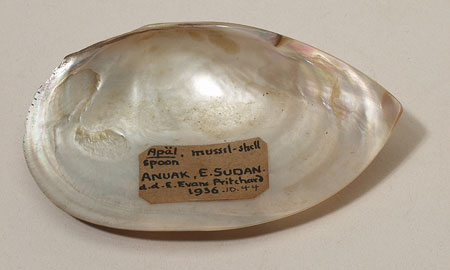Accession Number:
1936.10.44
Country:
Sudan
Region:
[Southern Sudan]
Cultural Group:
Anywaa [Anuak]
Date Made:
By 1936
Materials:
Mussel Shell , Mother of Pearl Shell
Process:
Carved
Dimensions:
Max L = 93 mm Max W = 55 mm Max H = 13 mm Th edge = 1 mm [RTS 1/7/2004].
Weight:
12.8 g
Local Name:
?apäl
Other Owners:
Presumably collected by Evans-Pritchard during his period of fieldwork amongst the Anuak between early March and May 1935 [RTS 18/6/2004].
Field Collector:
Edward Evan Evans-Pritchard
PRM Source:
Edward Evan Evans-Pritchard
Acquired:
Donated 1936
Collected Date:
March - May 1935
Description:
Spoon or scoop made from one half of a mussel bivalve shell, separated from its paired shell at the hinge.
This is largely oval in plan view; the edges have been ground down and it has been cut at one end to form a point, and given a series of small v-shaped notches in the opposite end to produce a serrated edge; these become extremely small in places, where it looks as though the surface may have been further worn through use or otherwise ground down.
It has a convex underside that has traces of a light to mid brown surface (Pantone 464C), over half of which has worn away, leaving a cream coloured surface beneath (Pantone 7508C), and partially exposing the mother-of-pearl shell lining below.
The interior hollow is concave and made from this natural mother-of-pearl lining of the shell, which is an opalescent light pink to white colour.
There is some yellow staining to this interior, which may represent residues from use.
The spoon is complete, except for the surface damage described and some minor damage along the serrated edge.
It is 93 mm long, 55 mm wide and 13 mm high; the shell is around 1 mm thick near its edge, and has a weight of 12.8 grams.
Presumably collected by Evans-Pritchard during his period of fieldwork amongst the Anuak between early March and May 1935 (see (E.E. Evans-Pritchard, 1940, The Political System of the Anuak of the Anglo-Egyptian Sudan, p. 3).
The local name for this type of object was apäl. For similar spoons made out of mussel shells, see 1936.10.41-43; for a variant shell form with serrated end, see 1936.10.44-45. None of these shells make up the two halves of a single bivalve. These spoons were stored in a small basket, 1936.10.46, called akoga . Similar shells, used as spoons or ladles, are known amongst the Dinka Tuich (see 1979.20.57-8). Patti Langton described these as 'oyster' shells, but they seem to be of the same type, and are probably also mussels.
Rachael Sparks 20/08/2005.
Presumably collected by Evans-Pritchard during his period of fieldwork amongst the Anuak between early March and May 1935 (see (E.E. Evans-Pritchard, 1940, The Political System of the Anuak of the Anglo-Egyptian Sudan, p. 3).
The local name for this type of object was apäl. For similar spoons made out of mussel shells, see 1936.10.41-43; for a variant shell form with serrated end, see 1936.10.44-45. None of these shells make up the two halves of a single bivalve. These spoons were stored in a small basket, 1936.10.46, called akoga . Similar shells, used as spoons or ladles, are known amongst the Dinka Tuich (see 1979.20.57-8). Patti Langton described these as 'oyster' shells, but they seem to be of the same type, and are probably also mussels.
Rachael Sparks 20/08/2005.
Primary Documentation:
Accession Book Entry
[p.
410] - 1936 [insert] 10 [end insert] E.
EVANS-PRITCHARD, M.A., Exeter College, Oxford.
- Specimens collected by himself in the EASTERN SUDAN, while travelling with a Grant from the
Rockefeller
Leverhulme Trustees, viz: [p.
412] [insert] 44-45 [end insert] - [One of] 2 ditto [Valves of mussel-shells], pointed at one end & serrated at the other end, used as spoons.
ANUAK.
Card Catalogue Entry - There is no further information on the catalogue card [RTS 30/1/2004].
Old Pitt Rivers Museum label - Apäl , mussel-shell spoon. ANUAK, E. SUDAN, d.d. E. Evans-Pritchard, 1936.10.44 [on label stuck to inside surface; RTS 1/7/2004].
Card Catalogue Entry - There is no further information on the catalogue card [RTS 30/1/2004].
Old Pitt Rivers Museum label - Apäl , mussel-shell spoon. ANUAK, E. SUDAN, d.d. E. Evans-Pritchard, 1936.10.44 [on label stuck to inside surface; RTS 1/7/2004].




